Google AdSense gives you a great way to monetize your website with text and display ads.
If you’ve got the traffic & topics and follow this AdSense guide, then you’ve got a revenue stream.
Yet:
Many sites are doing it wrong.
They’re showing ads but failing to get clicks – and no clicks equal no money.
Worse, they’re giving up the potential to make sales by sending visitors elsewhere for pennies!
This guide shares everything about how to make money through website monetization using Google AdSense. It covers the AdSense basics of getting started on improving AdSense earnings and more.
Google AdSense 101: Making Cents of Google Ads
Google’s primary business is selling ad space in the search results and their apps.
Businesses buy ads through the Google Ads platform. This platform lets them bid on keywords to display during relevant Google queries or app use. Google wanted a way to collect data about the Web while offering more ad space to businesses and voila, Google AdSense was born.
What is Google AdSense?
Google AdSense is a free-to-use advertising platform available to website owners and content creators. Joining the program provides access to easy-to-install code displaying ads within the Google Ads system.
Google AdSense is perfect for:
- Blogs
- Forums
- Online Tools
Google crawls your content looking for keywords helping it place relevant ads. A website dedicated to gaming will show ads from gaming companies, as an example.
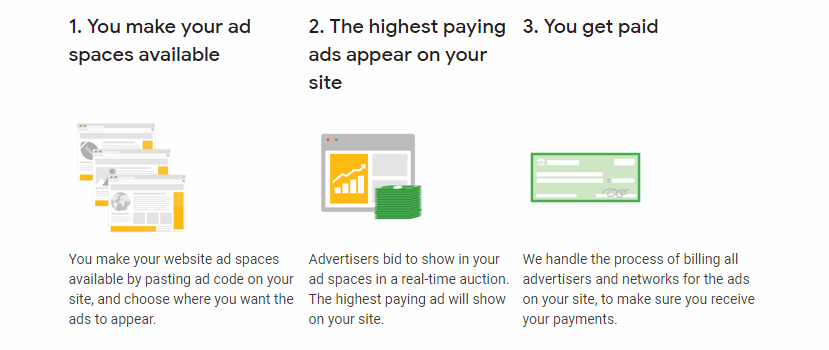
Google provides many ads formats to monetize a website.
These are the top performing AdSense ads according to Google:
- 300 x 250 (Medium Rectangle)
- 336 x 280 (Large Rectangle)
- 728 x 90 (Leaderboard)
- 300 x 600 (Half Page)
- 320 x 100 (Large Mobile Banner)
…and about two dozen AdSense ad formats for you to experiment.
Plus, even more between text and display-based ad choices.
The appeal of monetizing with Google AdSense is not dealing with advertisers. Google is the liaison negotiating the best ad pricing and placement for both publisher and advertiser. The tool provides real-time reports helping you understand site/AdSense performance. Google also backfills ads (swapping sizes/ads) to increase competition.
Google Ads are also widely available through video games, apps, and YouTube videos.
Follow the Webmaster Guidelines and you’ll likely make money with AdSense within a day of signing up and adding ads to your website.
How Much Can I Make with Google AdSense?
There’s no limit to how much you can make with Google AdSense.
Google AdSense pays via:
- CPC (cost-per-click)
- CPM (cost-per-mille)
- CPE (cost-per-engagement)
Most publishers with high traffic stats choose the CPM model paying for every 1,000 visitors.
The money you’ll make is dependent on elements like your site’s topic and paired ads and number of page views.
More traffic = more ad exposure = more earnings
The CPC Google AdSense model pays when users click ads displayed on your site. But, do remember clickthrough rates are generally low (in general) especially so because of ad blindness.
Google AdSense uses RPM factoring:
- Click through rate
- Cost per click
This provides a baseline of how much you can expect per 1,000 visitors. The true RPM depends and fluctuates regularly as advertisers come and go, traffic spikes, and audience engagement.
There are a few case studies and reports trying to debunk how much Google AdSense pays – like:
- $2 – $3 per 1,000 impressions via CPM
- $5 – $10+ per 1,000 impressions via CPC
- $3 – $5 per 1,000 views (on YouTube)
Google takes an estimated 32% cut of the content advertising and 51% from search according to an AdSense share breakdown by SearchEngineLand. Though, it’s hard to truly say Google tends to remain cryptic with the behind-the-scenes.
Google AdSense Pros and Cons
The real question is whether Google AdSense is a good fit for your website.
The AdSense platform provides an easy way to monetize a site, but it may not pay well for certain sites because of their niche selection. Some categories are banned while others simply do not have big spenders.
Likewise, a large website commanding thousands of daily visitors could turn to branded partnerships and ads set to higher costs. This is like exchanging pennies for visitors compared to earning a lot more through sponsorships.
Let’s consider the positives and disadvantages of using Google AdSense:
Google AdSense Pros
- Easily implemented with a few lines of code
- Many ad formats to fit the look & feel of your site
- Vetted advertisers promoting real products & services
Google AdSense Cons
- Ads are annoying and intrusive to the site experience
- Google gets a big chunk of the earnings
- Working directly with brands yield better payouts
Should I Use Google AdSense on My Site?
Google AdSense is a great opportunity to monetize, no doubt.
The platform is easy-to-implement and seamlessly integrates with Google Analytics. The ads are highly relevant if you’re creating targeted, SEO-friendly content.
You will make money with AdSense if you’re creating a “sticky” website.
Yet:
AdSense ads, just like all ads, are annoying to most users getting in the way of content. Many new AdSense publishers overload their site breaking the user experience. Don’t do this. If you choose to use AdSense, then make it a part of the design and experience.
If anything, experiment.
Do a trial run of AdSense seeing how well it performs for your website, niche, and audience. If earnings are promising, then consider optimizing their placement. Else, drop the ads for something better or simply keeping the site clean until you’re ready to monetize using other methods.
How to Create a Google AdSense Account: A Visual Step-by-Step Guide
There’s no real difficulty with how to register Google AdSense.
It’s mainly a waiting game until account approval.
Let’s get you set up.
Step 1: Visit Adsense.Google.com and click ‘Sign Up Now’
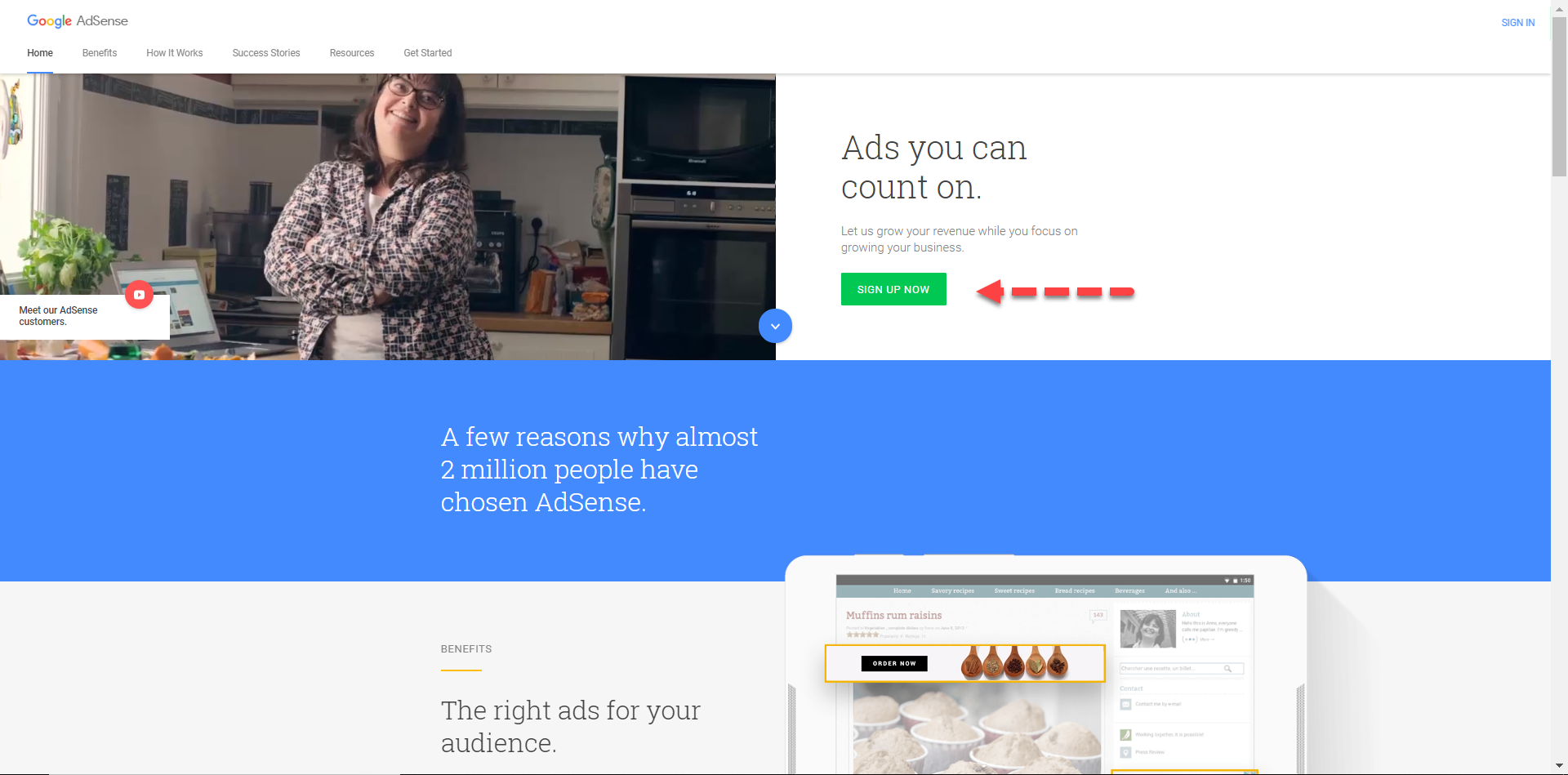
Step 2: Add Your Website and Email Details
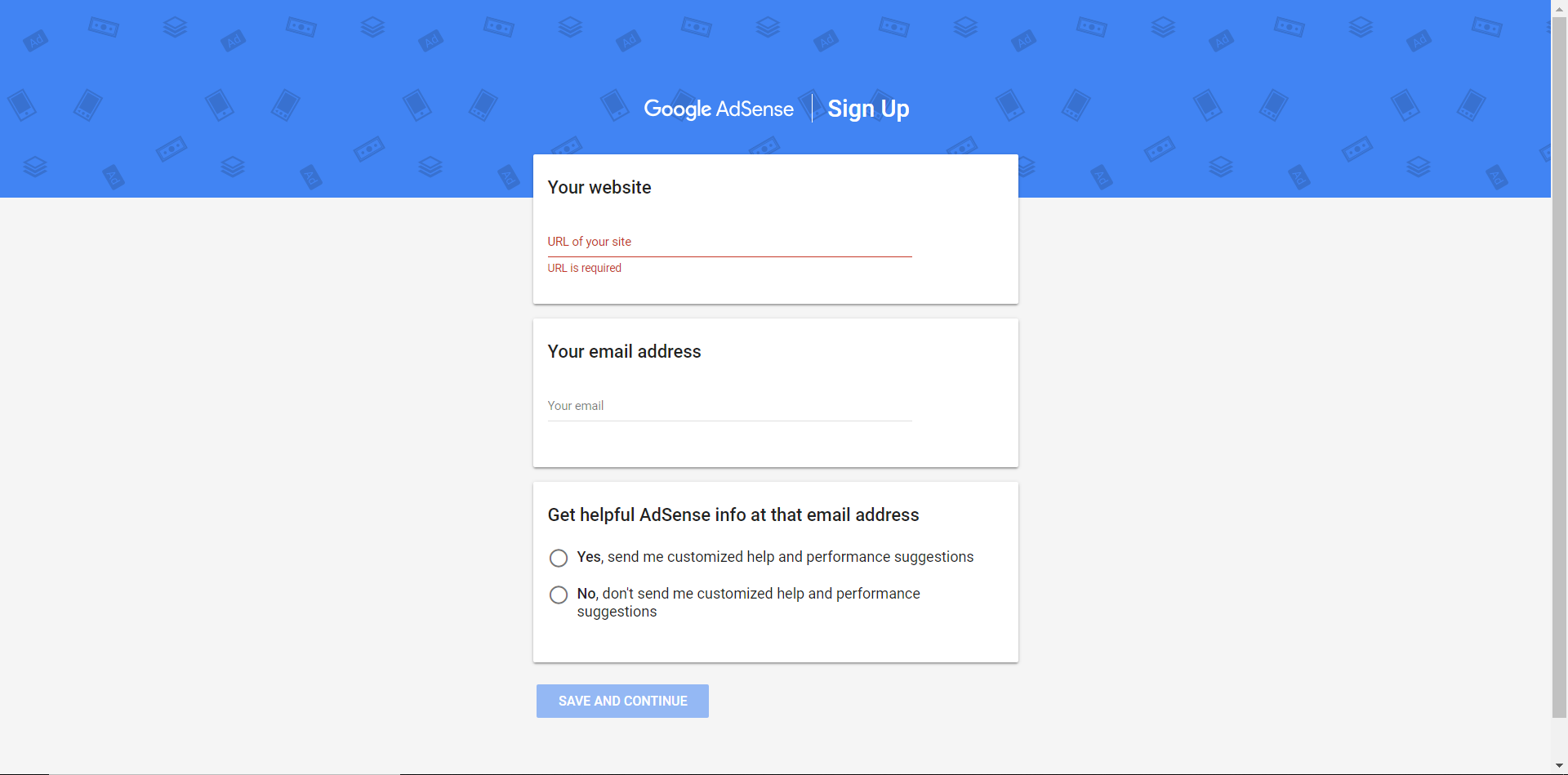
Step 3: Sign In to Your Google Account (Else, Follow Prompts)
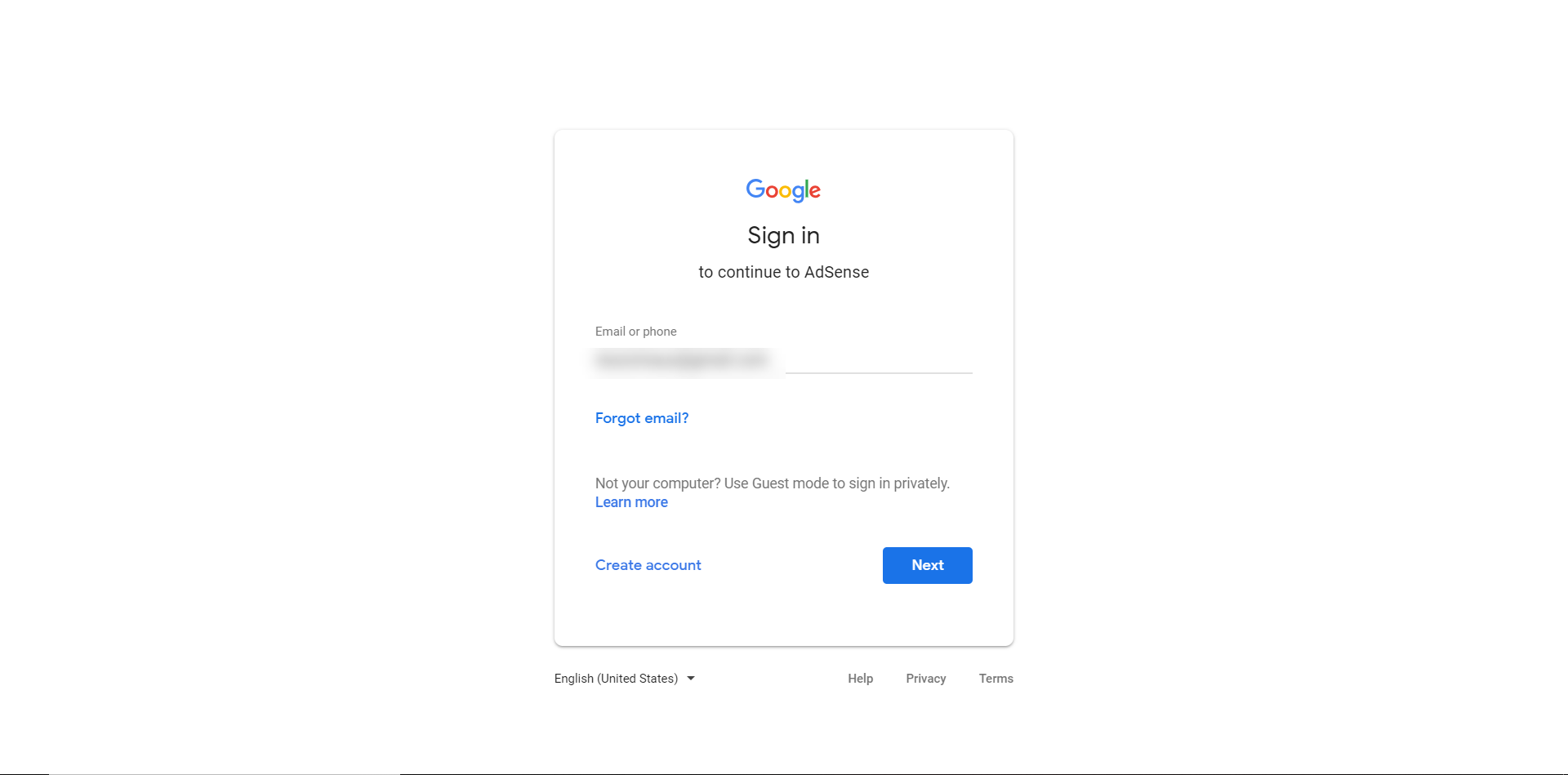
You are prompted with a Google sign-in if registering with a Google account. We recommend you create one for the sake of integrating Google Analytics and Gmail for simplicity. Follow the prompts if you choose to register using a different email type.
Step 4: Navigate the Verification Page
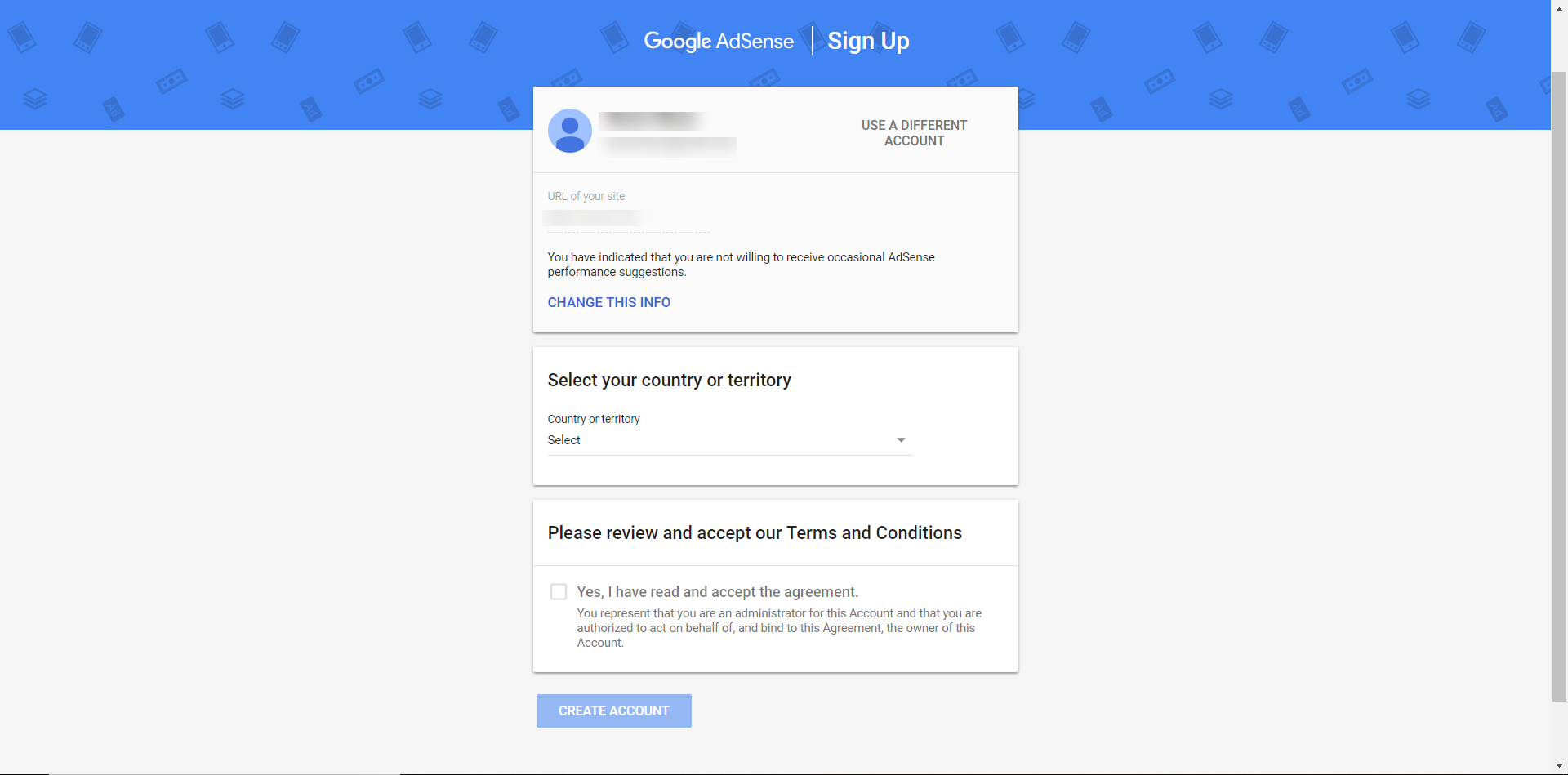
Step 5: Select Your Country or Territory

Step 6: Agree to the Terms and Conditions
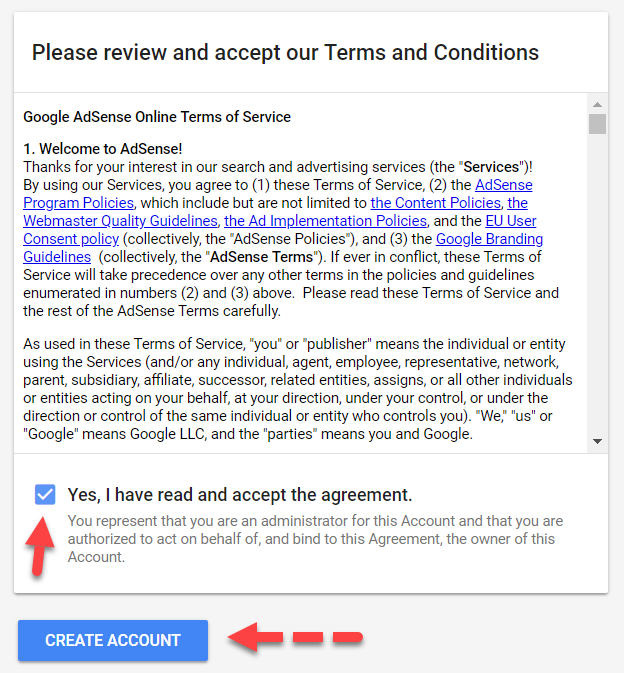
Step 7: Fill In Your Payment Details
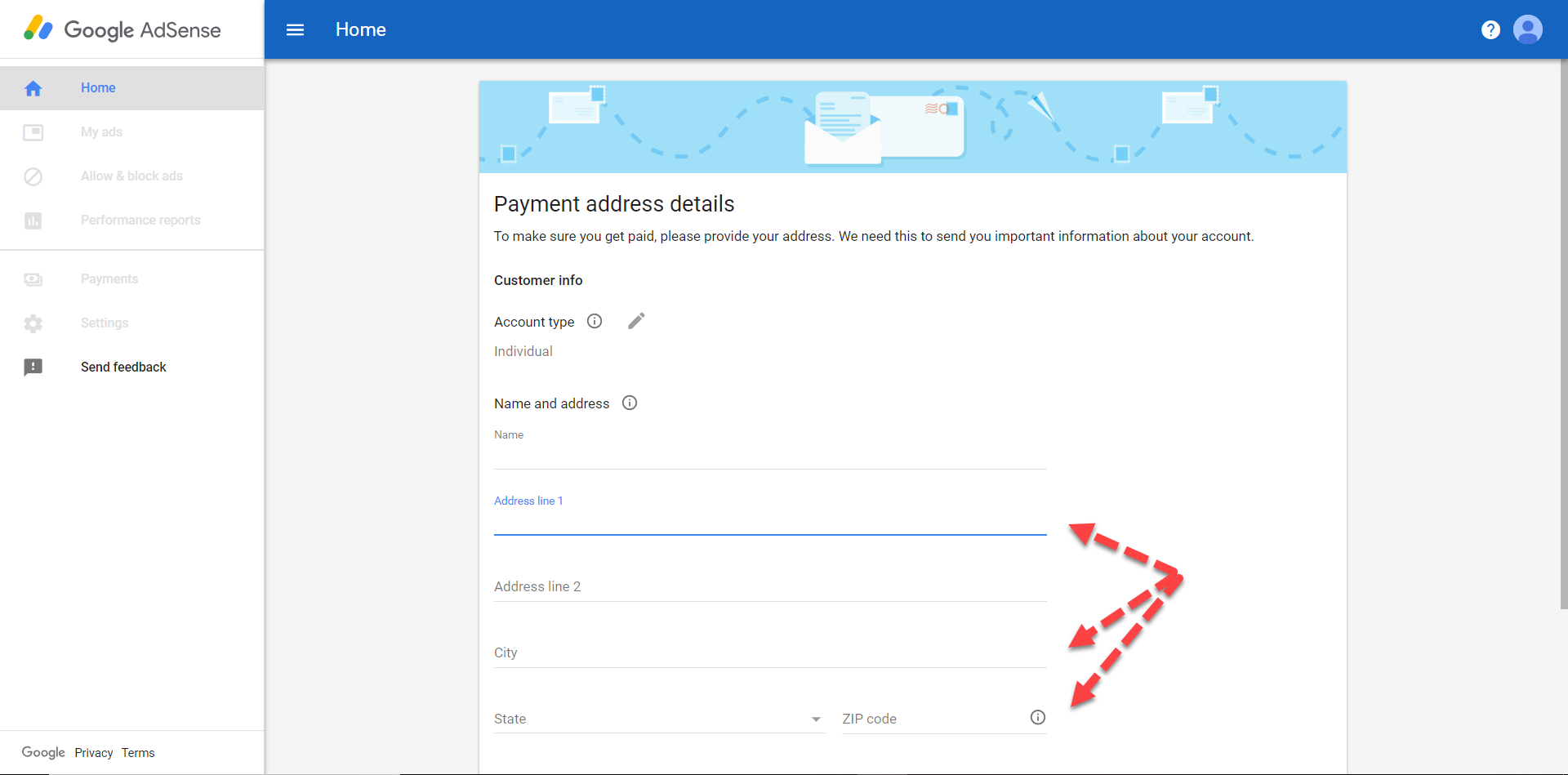
Step 8: Verify Your Phone Number
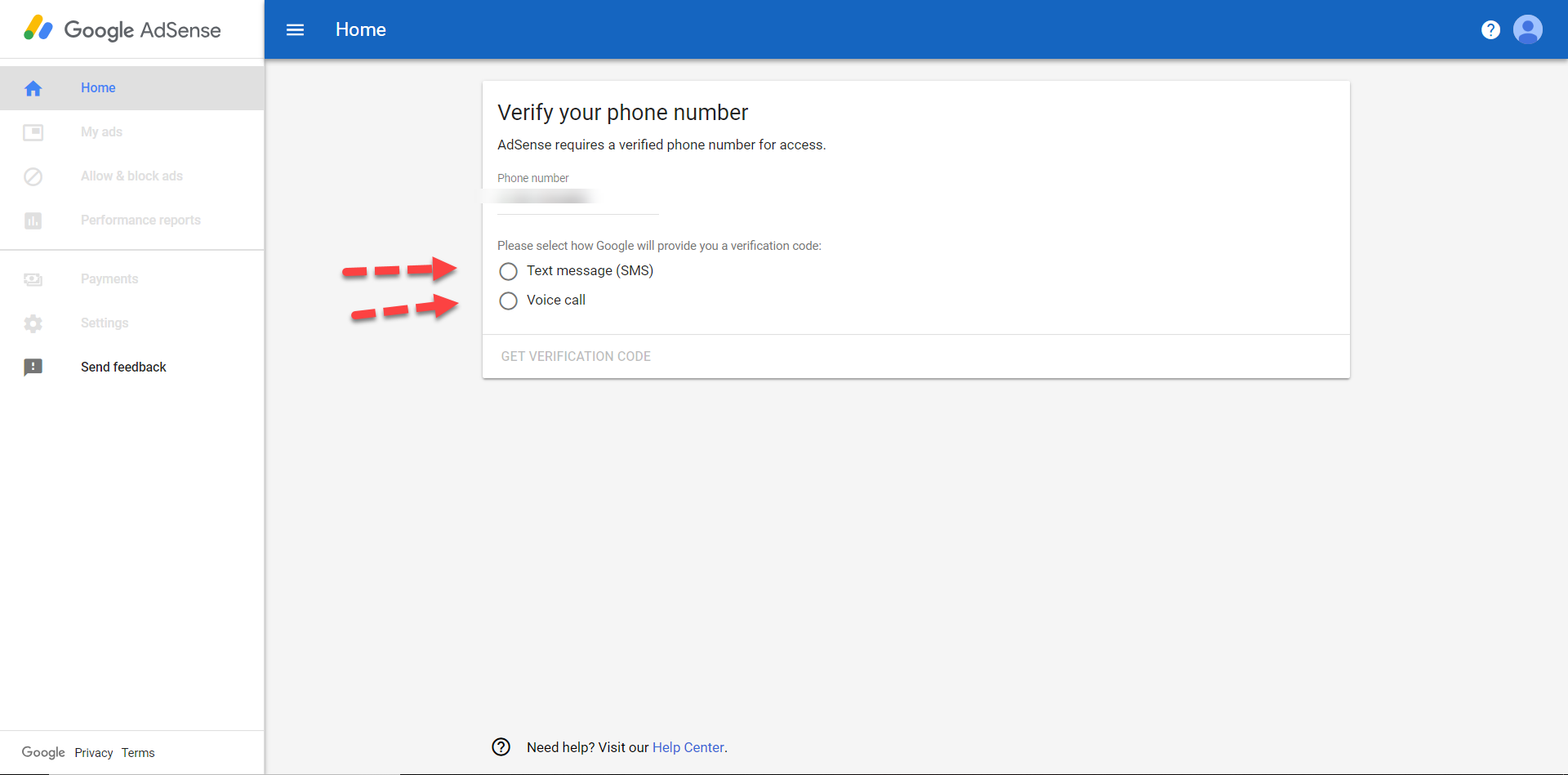
Step 9: Submit Your Verification Code
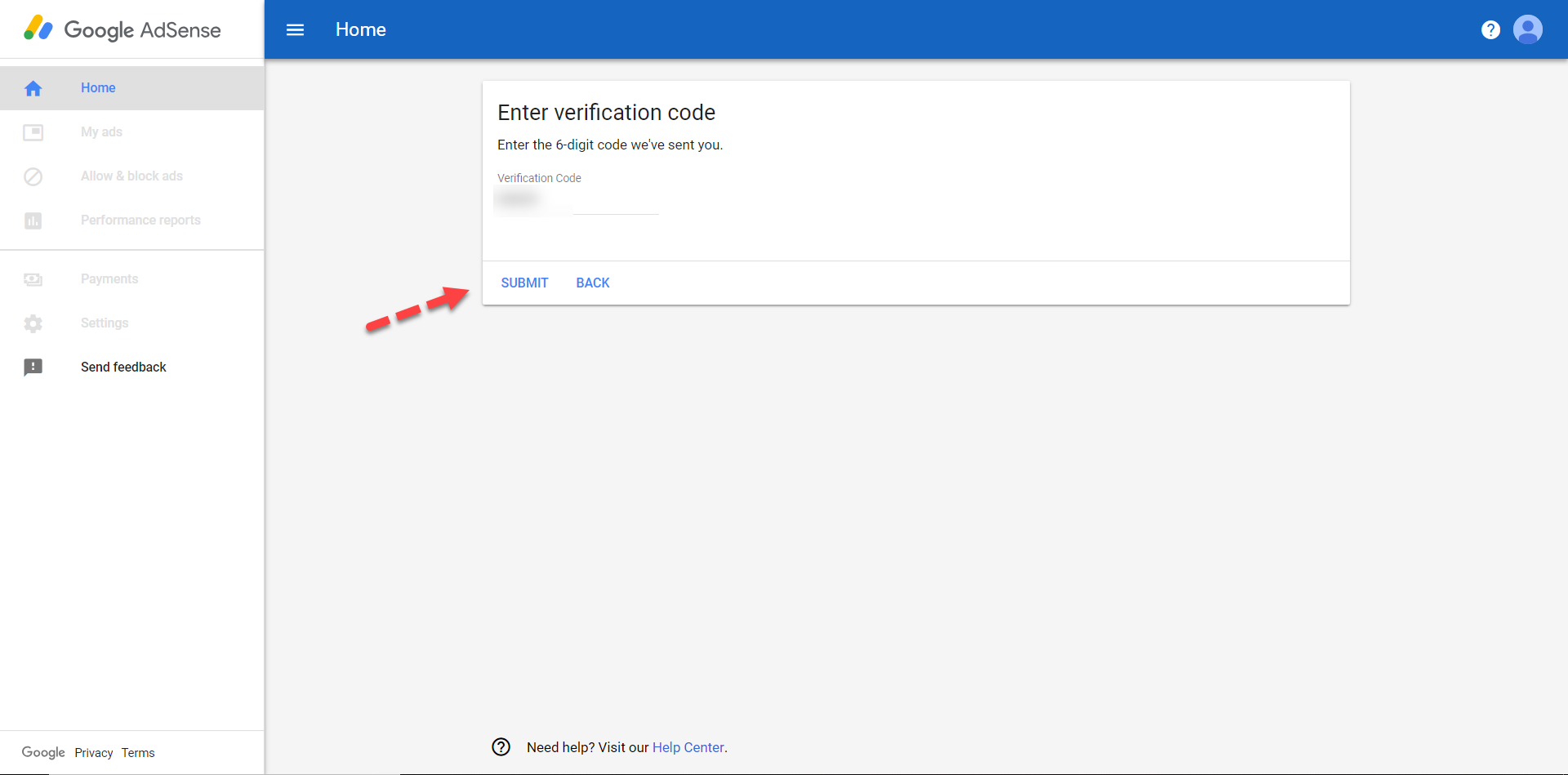
Step 10: Connect Your Website
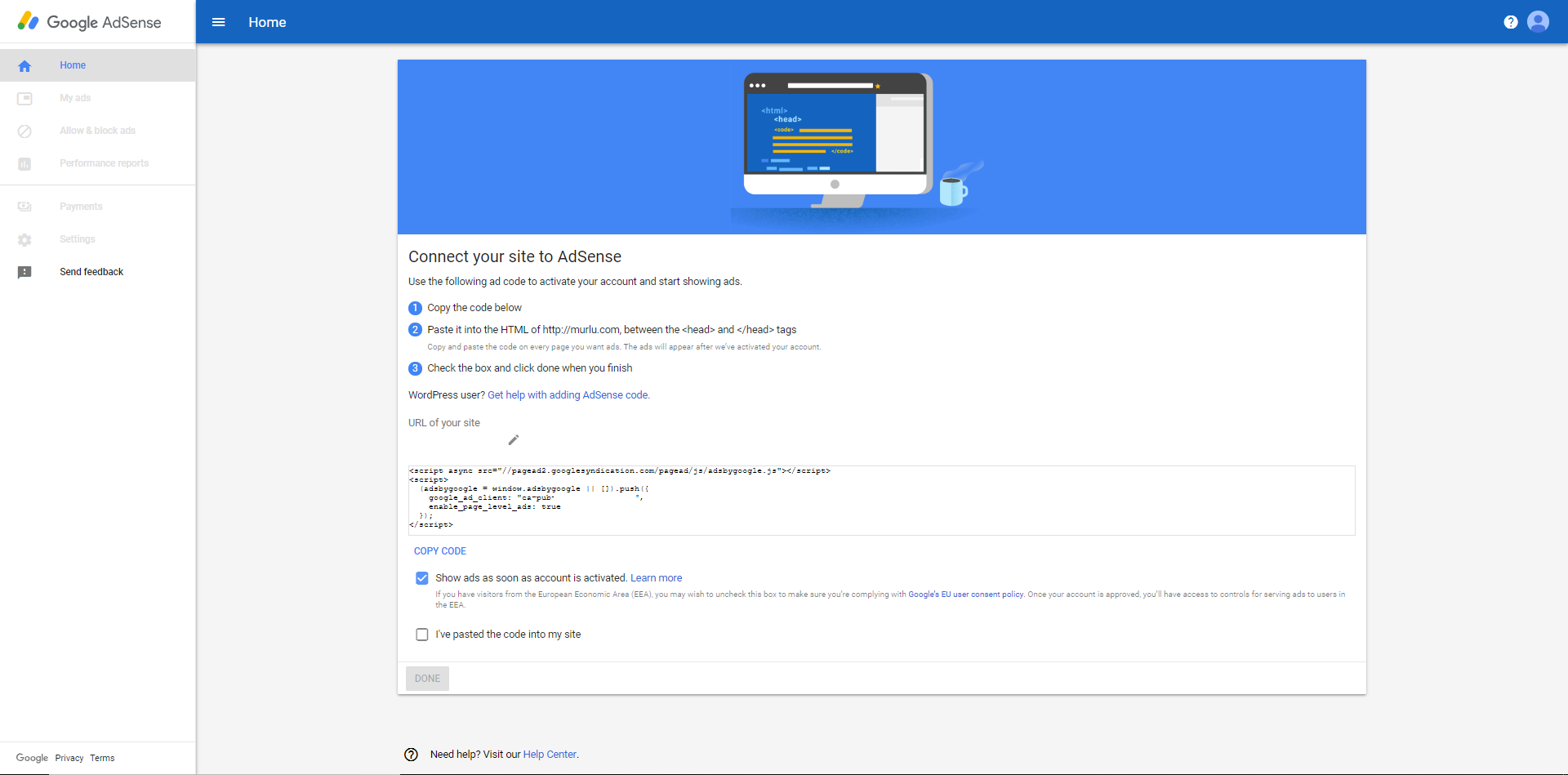
This is the splash page you’ll find after submitting your information.
Step 11: Copy Your AdSense Code

Step 12: Confirm Your Code and Click ‘Done’

Step 13: Your Account is Activated

You now have the option to copy AdSense code to your website or save for later.
Congratulations! You’ve set up your Google AdSense account!
The verification process may take 24-hours (or more).
Now’s a good time to prepare yourself for the upcoming Google Ads by brushing up on HTML basics. Or, installing a plugin to easily add the AdSense code to your website (see below).
How to Add Google AdSense Ads to Your Website or Blog
We’ve come to the point with how to set up Google AdSense on your website.
This is a continuation of the prior section starting where we left off with the account creation.
The first thing you’ll notice when joining the AdSense program is a welcome page sharing your AdSense code.
You may manually select and copy/paste the code. Or, use the ‘Copy Code’ prompt.
Save this code or keep the tab open while you work through the following…
The Easy Way to Add Google AdSense to a Site (Plugins)
WordPress powers 30% of the Internet so we’re assuming you’re on this platform. If you’ve yet to start a site (which is weird considering you’re reading a guide to Google AdSense already), then we recommend you follow along with our guide to building a WordPress blog.
For those on other platforms like Squarespace, Wix, and hand-crafted sites – you’ll find included tools to add code snippets to your website.
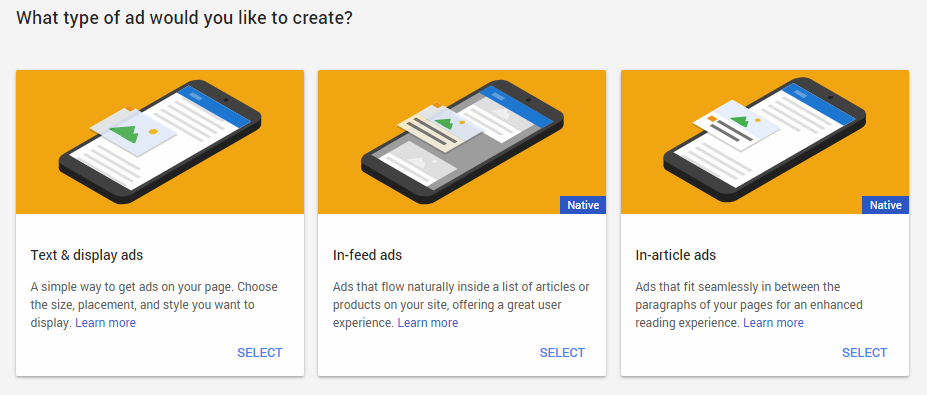
Else, you may use free/paid plugins & scripts to do the following.
There are a few WordPress AdSense plugins basically doing the same thing, like:
- Quick AdSense
- Google AdSense Plugin
- Easy Plugin for AdSense
However, Google closed their supported AdSense plugin in 2017 preventing older plugins from manipulating AdSense ads. These plugins provide a quick-and-easy way to integrate AdSense, but you don’t have a lot of control – breaking your site with these are very common.
Use a code injection plugin in place of Google AdSense WP plugins.
Google recommends:
- Insert Headers and Footers plugin
- Advanced Ads plugin
- Ad Inserter plugin
These have better support and features plus gives you control of the ad space if you decide to swap Google AdSense for an alternative.
We’ll let the Advanced Ads team explain the process via video:
Other ad injection plugins operate in the same manner with differences in their configuration. These shouldn’t pose a problem if you take a few moments to understand the dashboard and features.
The Hard Way to Add Google AdSense to a Site (Manually)
Although we say this is the “hard way”, it’s not really.
If you can copy & paste, then you can manually add Google AdSense to your website.
Note: We recommend creating a website backup before you begin changing the code. You’ve been warned.
Head back over and retrieve your Google AdSense ad code.
You may configure the ads based on your preferences or use Google’s automated features to determine the best formats/sizes/types for the area.
Add a Sidebar Text Widget or Paste the AdSense Code
Many website themes and CMS’s have sidebar options letting you embed code using a widget:
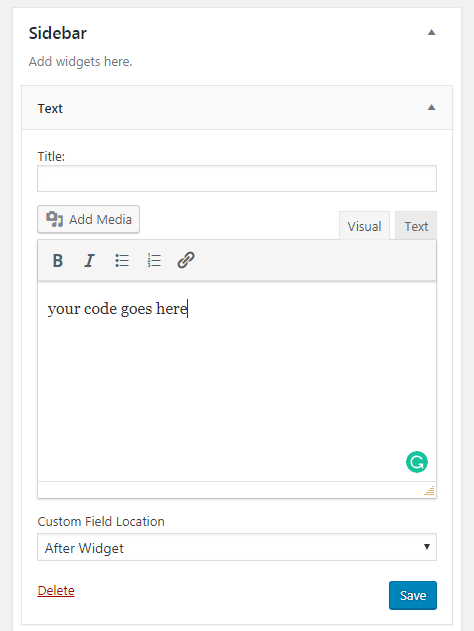
This displays an AdSense ad in your sidebar autoconfigured to the themes design & layout. Google notes you may not implement some ad formats (like Page-level ads/Native ads) through text widgets. But, WordPress is constantly evolving so keep checking if these features become available!
Otherwise:
- Locate the sidebar section in the website’s theme
- Create a new DIV code block
- Paste the AdSense code
- Configure the DIV using CSS
You may copy/paste existing sidebar blocks, stripping the code, and reusing it for this purpose.
Add an Ad Block to the Header or Footer
Adding AdSense to your header and footer is a fantastic idea since it’s above the fold.
This creates higher impressions and possible click-through rates since they’re one of the first items noticed on the page.
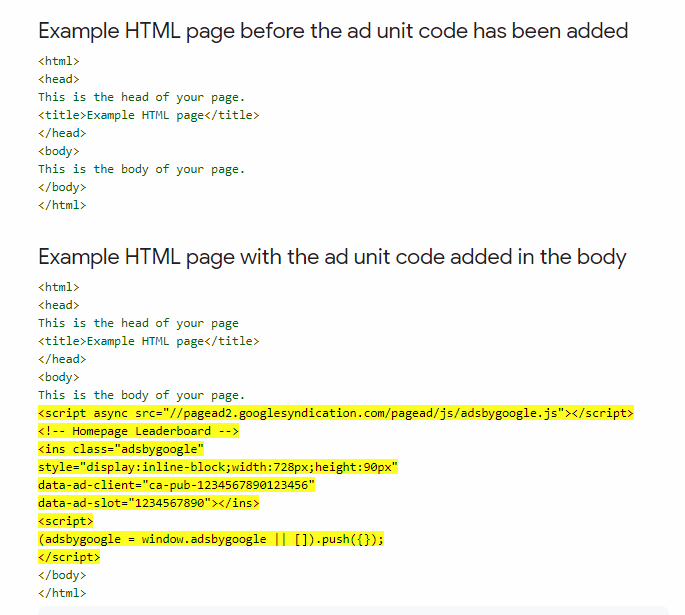
This example is straight from Google in their ad pasting guide.
These header/footer ads are also less intrusive since they don’t break the body content.
- Navigate to the head or footer block of code
- Add a div element to contain the ad code
- Paste your AdSense code into this area
Horizontal banners are usually the best options for these sections since it won’t push content too far below the page. Though, you’re welcome to experiment with different ad formats changing the site layout to accommodate the design.
Add AdSense to the Website Content
You could:
- Add inline AdSense units
- Add AdSense code through includes/scripts
It’s easiest adding AdSense in the body content if you’re editing pages manually. All that’s needed is a copy/paste of the code to the area you want such as below the page title or half-way into the post.
Go to My Ads > Ad units > New In-article Ad
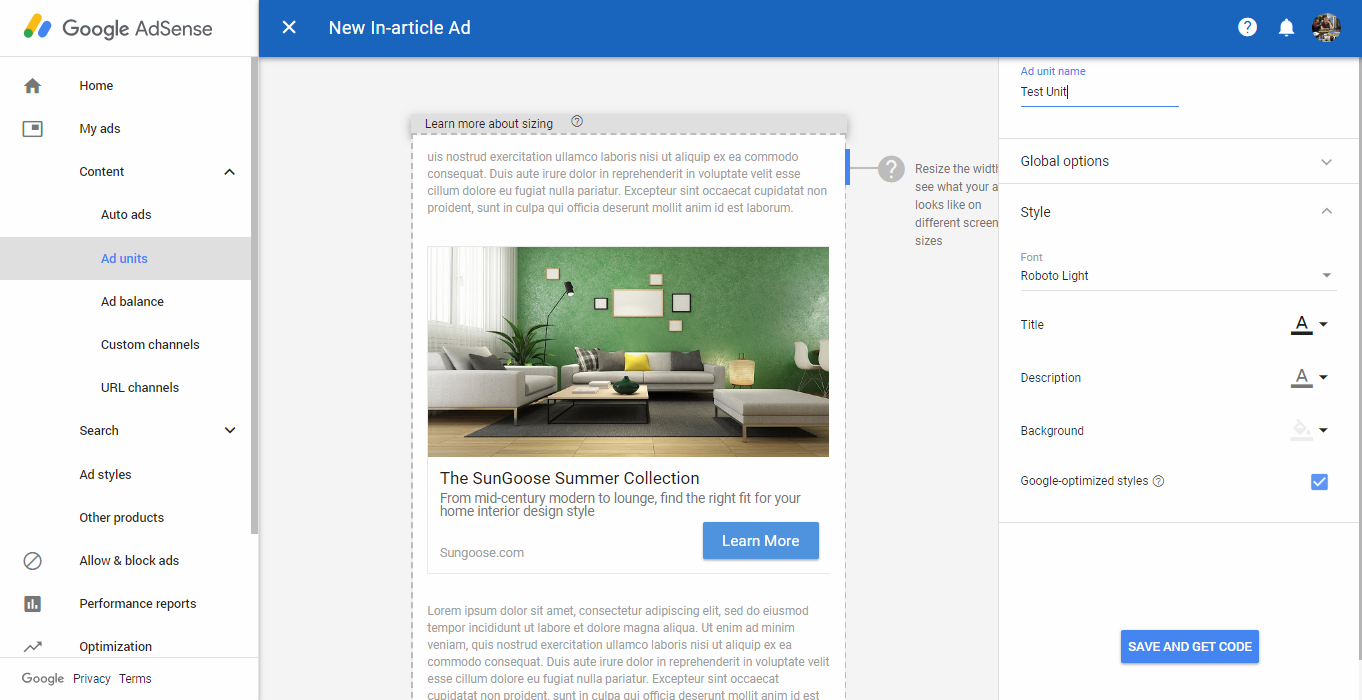
Then Save and Get Code > Copy Code Snippet
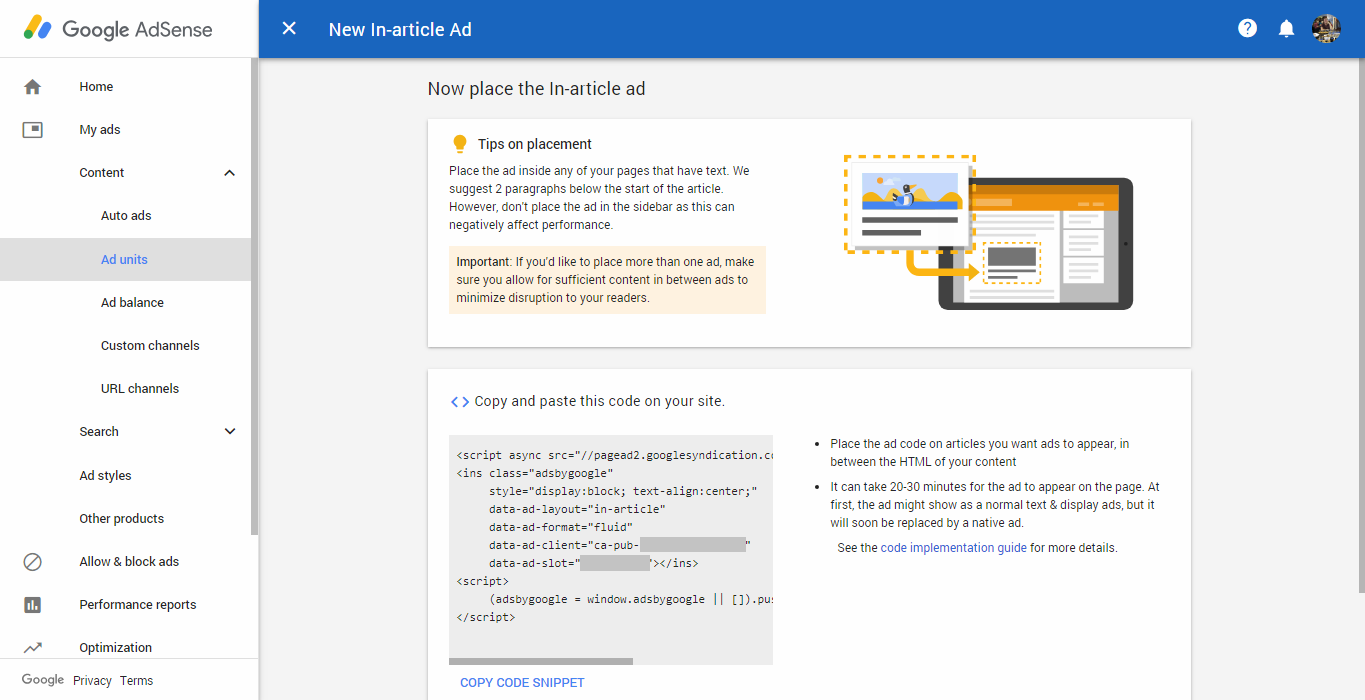
You can gain better control of the ad unit wrapping it in a DIV tag. This will let you control its page placement as if you need a padding/margin. Or, center-aligning the ad unit.
- Open the web layout and find the desired ad location
- Create a new section (like a div tag)
- Paste the AdSense code into this block
Save and test the ad display looking for errors – else pass this work to a virtual assistant or developer.
The Ads should begin showing almost immediately but sometimes take a few minutes. Make sure the ads don’t break the site layout, delete or revert to an old save if they do.
Experiment with the AdSense Placement
Every site’s use of AdSense is influenced by its users:
- Tech-type sites attract tech-savvy users likely to avoid ads all-together
- Feel good-type sites attract general users likely to at least entertain the ad
You should try different spots tracking how they perform to find the best AdSense placement for your site. This is a great opportunity to learn and master your CMS or site’s code.
Don’t want anything to do with installing AdSense on your site?
- Hire freelance Web developers to embed Google Ads
- Use drag-and-drop site builders to add AdSense without code
Most importantly: Give it some time so you have real data about your AdSense performance before swapping ad placement on a whim. See more on this later.
Google AdSense Earning Tips and Best Practices
There are three common ways to increase Google AdSense earnings:
- More traffic
- Better Ads
- Higher click-through
We’ve covered traffic generation extensively whether it be social media traffic to creating tons of organic traffic with long-tail keywords.
Try one, or all, of the following from our website traffic checklist to get more traffic:
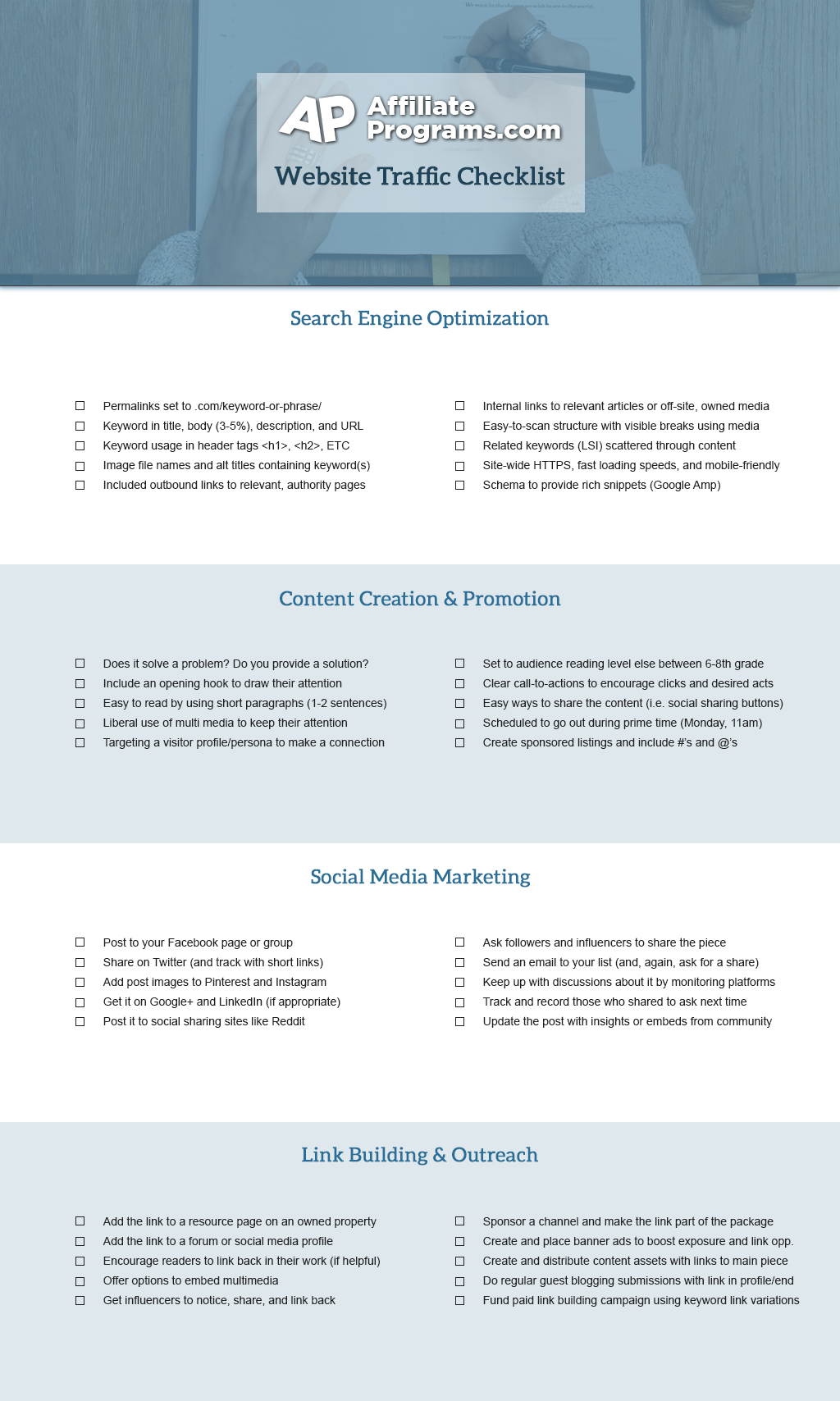
Better ads go together with better content which happens to increase organic traffic.
Who’d of thought?!
Build better content and subsequent AdSense earnings via:
- Better Keyword Selection – Using Google AdWords to find high-value keywords advertisers pay top dollar for and including those as topics or long-tail phrases in your content. This isn’t an open call to stuff your posts – simply refine your selection using metrics and data.
- Longer Blog Posts – Long posts, like this one, include more keyword phrases, questions, and search terms naturally by way of its scope. A long post tends to rank higher in search because it introduces many keywords while displaying a greater range of AdSense Ads.
Finally, higher click-through rates create higher earnings (more clicks, more money) – usually from:
- Better Ad Placement – Experiment with ad placement using heatmapping tools, like Hotjar, finding the areas garnishing heightened interest. Place ads where people linger and focus.
- Better Content “Flow” – The “flow” is how your visitor proceeds through the page’s content giving you a chance to place ads where they take breaks. Think of this as the commercial break to your website’s content. They’ll dwell long enough to absorb the message and may click.
There’s also the notion of creating “passable” content – content covering the topic but leaving the visitor wanting more. The ad displays a tool or resource fulfilling this need to keep going or accomplish a challenge introduced in the post.
10 Best Ways to Maximize AdSense Earnings
We’ve done some research and found these to be the general consensus of what’s effective with increasing AdSense earnings:
- Test various ad formats finding the one (or two) best for your site and its audience
- Place multiple ads on the page maximizing CPM (without being too disruptive of the content)
- Try creating geo-targeted content pulling ads from local advertisers and brands
- Use the “Allow & Block” feature to remove low-performing ad categories from your site
- Focus on delivering traffic from the U.S. and U.K. more-so than most other countries
- Test between text-based and image-based ads finding which resonate with your audience
- Expand AdSense Ad exposure through other channels like Blogger and YouTube
- Make a faster site and mobile-ready so you’re not hit by Google SEO penalties
- Use a better website theme with an elegant, easy-to-navigate design
- Copy successful AdSense sites replicating their placement and flow
Central to each effort is…
Using Google Analytics and Webmaster Tools to Improve AdSense Earnings
Google AdSense is tightly integrated with Google Analytics.
The two options provide deep insights into your website you can use to improve AdSense earnings. A few minutes understanding your site performance, topics, and rankings can refine efforts delivering a better ad experience to visitors.
Webmaster Tools provide search index insights also providing hints and ideas to increase AdSense revenue. This tool is available (freely) to those with a Google Account after site verification.
- Log into your Google Analytics account and navigate to the dashboard
- Click the Behavior tab and All Pages option
Here, you will find your best performing website pages (those with the highest traffic). This selection should give you a great starting point – a top 10 – for website optimization.
Try improving:
- LSI Keyword Use – Search Google for the primary keyword and reuse related search queries displayed at the bottom of the page. Or, use AnswerThePublic to find relevant search terms and queries you could add as small topics further building-out long-form content.
- Link Building Efforts – Use Webmaster Tools to find which sites link to your sand foster those relationships. Use tools like Ninja Outreach to find similar websites of those linking and create an outreach campaign to guest post, ask for links, or if they’d contribute to your site.
Data is your weapon for improving AdSense earnings. Use it!
The Google AdSense Tutorial Wrap Up
What a journey.
We’ve covered a whole lot about Google AdSense in this post. There’s a lot to digest.
Take your time working through the process.
Google AdSense creates a great way to monetize a website but there’s more to it than slapping content together and plastering ads, calling it a day. Strive to build an authority site above anything else if this is your primary website – aim for the long-term sustainability versus penny clicks.
AdSense revenue will grow as your site’s traffic and brand awareness increases. Be patient.
There’s nothing stopping you from exploring AdSense.
Let us know what you think.
Give it a try.




